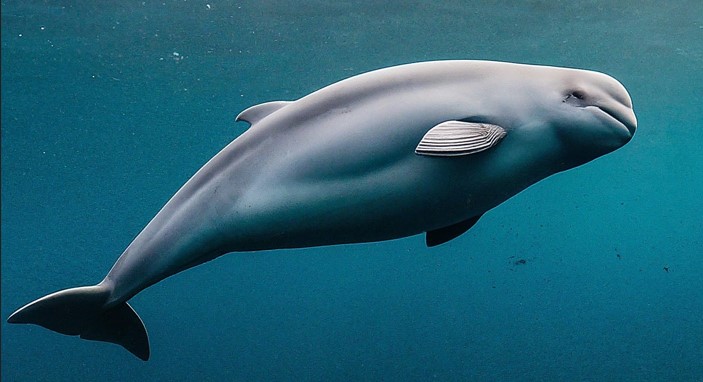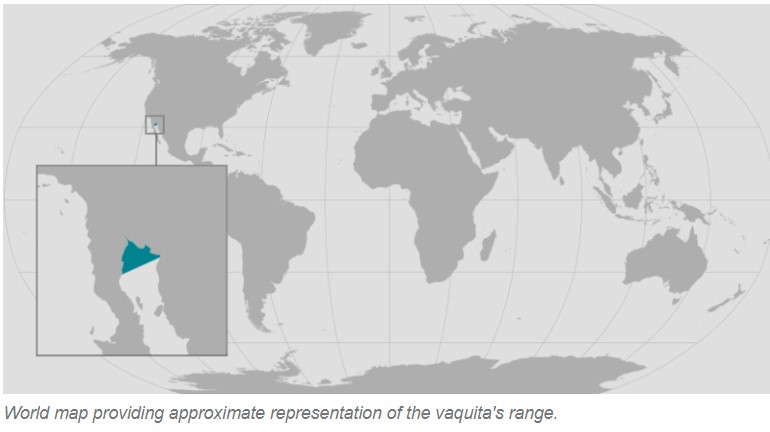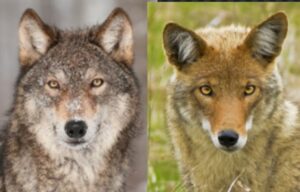VAQUITA PORPOISE

VAQUITA CETACEAN, SHUTTERSTOCK LICENSED IMAGE
The Vaquita: A Silent Struggle for Survival and a fragile existence in the Gulf of California. Vaquita in Spanish means “little cow.”
BY SNN.BZ STAFF
The vaquita, a mysterious and elusive porpoise, inhabits the northern reaches of the Gulf of California. Despite its small size, this marine mammal faces an existential crisis. With fewer than 20 individuals remaining in the wild, the vaquita is perilously close to extinction. Let’s dive into the fascinating world of this endangered species and explore the challenges it confronts.
The Threats
Gillnets and the Silent Killer:
Vaquitas inhabit an area rich in fish and shrimp, making it a prime location for fishing.
The Totoaba Connection
Enter the totoaba, another Gulf of California resident. Totoabas are large fish sought after for their swim bladders, which are believed to have medicinal properties. Gillnets set for totoaba inadvertently capture vaquitas, leading to their decline.
Illegal Trade and Smuggling
Totoaba swim bladders are smuggled to China, where they command high prices. Thousands of dried swim bladders are trafficked, sometimes passing through the United States. The vaquita pays the price for this illicit trade. Unfortunately, the same gillnets that sustain local livelihoods also entangle and drown vaquitas. These fine-meshed nets are like invisible traps, ensnaring unintended victims.
Conservation Efforts
Desperate Measures
Scientists and the Mexican government recognize the urgency. Emergency gillnet bans were imposed, but the vaquita population continued to plummet. President Peña Nieto’s visit to San Felipe marked a critical moment, announcing a two-year ban and compensation for affected fishermen.
Perilous Waters
A federal agreement banned most gillnets, except those for curvina and sierra. Yet illegal gillnet use persists, pushing the vaquita closer to extinction.
Where They Thrive
The vaquita, a diminutive porpoise, claims an exclusive address—the northern part of the Gulf of California in Mexico. Within this limited range, vaquitas find their haven, a mere 1,519 square miles—smaller than a quarter of metropolitan Los Angeles. Here, the Delta of the Colorado River Biosphere Reserve unfolds, a vibrant marine habitat teeming with diverse fish, birds, reptiles, and mammals.

Lifespan and Family
Vaquitas defy their size, living up to 21 years. Sexual maturity arrives between 3 to 6 years. Pregnancy lasts a remarkable 10 to 11 months. Females, like devoted mothers, give birth every other year to a single calf, weighing in at 2.5 feet and 16 pounds. The birthing season, a coastal celebration, unfolds from February to April.
The Perilous Web of Gillnets
The vaquita’s fate hangs by a thread—entanglement in fishing gear. Once an accidental victim, vaquitas found themselves ensnared in small-scale and commercial fisheries. The mid-20th century witnessed a devastating gillnet fishery for totoaba, pushing vaquitas to the brink. Even after the totoaba fishery closed in 1975, vaquitas continued to perish in illegal totoaba nets and shrimp-fishing gillnets.
A Lethal Dance with Totoaba
Scientists meticulously studied vaquita mortality rates from gillnets. Every type of net posed a threat, but totoaba nets emerged as the deadliest. The paradox: while totoaba numbers were low, shrimp gillnets silently claimed more vaquita lives. The decline between 1997 and 2008 mirrored fishing levels, revealing a grim reality.
The Black Market and the Swim Bladder
Enter the totoaba—a large fish with a coveted swim bladder. In China, totoaba swim bladders fetch astronomical prices for their supposed medicinal value. Fishermen chase the elusive bounty, earning up to $8,500 per kilogram. This illicit trade jeopardizes the vaquita’s survival, a tragic irony in the quest for prosperity.
The Vaquita’s Profile
Size and Appearance
At just 5 feet long, vaquitas are among the smallest members of the dolphin family. Their rounded heads lack a distinct beak, and black patches adorn their eyes and lips. Unique triangle-shaped dorsal fins help them regulate body temperature in warm waters.
Behavior and Diet
Shy and solitary, vaquitas avoid motorized vessels. Their inconspicuous surface rolls make them challenging to observe. They feed on small fish, shrimp, and squid, delicately balancing their ecosystem role.
Cetaceans are divided into two main groups:
Toothed Whales (Odontoceti):
These whales include species like sperm whales, orcas (killer whales), and belugas. They have teeth and are known for their intelligence, complex social structures, and echolocation abilities. Sperm whales, with their massive heads, dive to great depths in search of giant squid. Orcas, the apex predators, hunt seals, fish, and even other whales. Belugas, the “canaries of the sea,” communicate through a range of vocalizations.
Baleen Whales (Mysticeti):
Baleen whales, also called whalebone whales, have baleen plates for filter feeding. They include the blue whale, the largest animal on Earth, and the humpback whale, famous for its acrobatics and haunting songs. The gray whale undertakes one of the longest migrations, from Arctic feeding grounds to Mexican breeding areas. The fin whale, often called the “greyhound of the sea,” is sleek and fast. The minke whale, the smallest baleen whale, prefers cooler waters.
These diverse cetaceans play vital roles in marine ecosystems, captivating us with their grace and mystery.
DIFFERENCES BETWEEN PORPOISES AND DOLPHINS
Porpoises and dolphins share similarities as both belong to the order Cetacea, but they also have distinct features that set them apart:
Mouth and Teeth:
Porpoises have smaller mouths and spade-shaped teeth. Dolphins, on the other hand, tend to have prominent, elongated “beaks” and cone-shaped teeth.
Dorsal Fins:
The dorsal fin (the one in the middle of their backs) differs: Dolphins often have a hooked or curved dorsal fin. Porpoises typically have a triangular dorsal fin.
Body Shape:
Dolphins are leaner and sleeker. Porpoises appear more compact and sometimes look chubby in comparison.
Vocalization:
Dolphins are more talkative and make whistling sounds through their blowholes to communicate underwater. Porpoises do not exhibit this behavior, possibly due to structural differences in their blowholes.
Species Diversity:
There are far more species of dolphins than there are porpoises.
Both cetaceans are intelligent and fascinating creatures, each with its unique adaptations and ecological role in the marine world.





 Afrikaans
Afrikaans Albanian
Albanian Amharic
Amharic Arabic
Arabic Armenian
Armenian Azerbaijani
Azerbaijani Basque
Basque Belarusian
Belarusian Bengali
Bengali Bosnian
Bosnian Bulgarian
Bulgarian Catalan
Catalan Cebuano
Cebuano Chinese (Simplified)
Chinese (Simplified) Chinese (Traditional)
Chinese (Traditional) Corsican
Corsican Croatian
Croatian Czech
Czech Danish
Danish Dutch
Dutch Esperanto
Esperanto Estonian
Estonian Filipino
Filipino Finnish
Finnish French
French Frisian
Frisian Galician
Galician Georgian
Georgian German
German Greek
Greek Gujarati
Gujarati Haitian Creole
Haitian Creole Hausa
Hausa Hawaiian
Hawaiian Hebrew
Hebrew Hindi
Hindi Hmong
Hmong Hungarian
Hungarian Icelandic
Icelandic Indonesian
Indonesian Irish
Irish Italian
Italian Japanese
Japanese Javanese
Javanese Kannada
Kannada Kazakh
Kazakh Khmer
Khmer Korean
Korean Kyrgyz
Kyrgyz Lao
Lao Latin
Latin Latvian
Latvian Lithuanian
Lithuanian Luxembourgish
Luxembourgish Macedonian
Macedonian Malagasy
Malagasy Malay
Malay Malayalam
Malayalam Maltese
Maltese Maori
Maori Marathi
Marathi Mongolian
Mongolian Myanmar (Burmese)
Myanmar (Burmese) Nepali
Nepali Norwegian
Norwegian Pashto
Pashto Persian
Persian Polish
Polish Portuguese
Portuguese Punjabi
Punjabi Romanian
Romanian Russian
Russian Samoan
Samoan Scottish Gaelic
Scottish Gaelic Serbian
Serbian Sesotho
Sesotho Shona
Shona Sindhi
Sindhi Sinhala
Sinhala Slovak
Slovak Slovenian
Slovenian Somali
Somali Spanish
Spanish Sundanese
Sundanese Swahili
Swahili Swedish
Swedish Tajik
Tajik Tamil
Tamil Telugu
Telugu Thai
Thai Turkish
Turkish Ukrainian
Ukrainian Urdu
Urdu Uzbek
Uzbek Vietnamese
Vietnamese Welsh
Welsh Yiddish
Yiddish Yoruba
Yoruba Zulu
Zulu